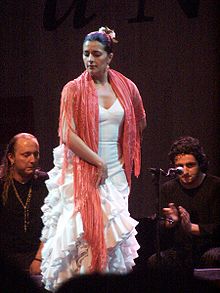- Manila shawl
-
The Manila shawl is an embroidered silk shawl associated with the Port of Manila.
History
Its name is associated to the Port of Manila (Philippines), however, its origins are in China. Manila is the port where the Spaniards collected the products of the Far East during the fifteenth century. These products were subsequently sent via the Manila Galleons to New Spain (Mexico), where it was further distributed to Europe. In China, shawls were made of silk and were embroidered by hand, generally with flowers or birds. At first, they were decorated with dragons, bamboo, or pagodas (Chinese typical decorations). On their dimensions is significant to mention that owed - at least - to cover all the back and to arrive at the extreme of each arm, when these are located in position of cross with the bust. On the other hand is to emphasize that the more light be concocted, a lot better to be able to bear it comodamente on the body and to light up with more distinction upon performing movements or you figure (in this last case and more exactly, refers to its utilization generalized by the dancers (bailaoras) of flamenco).
The embroidered shawl is associated with the flamenco dance, although is a complement of the dress used also by the flamenco singers and besides, in some epochs, has been used like a routine token.
The origin of the embroidered Shawl is in China. The first shawls embroidered and other tokens, like kimonos, cushions or pictures were done in China. Traditionally they were carried out in silk and they were embroidered by hand with floral motives of nature as flowers, birds, and Chinese motives: pagodas, dragons. ..todo set in the oriental landscape.
Although the shawl's origin is in China, it was Manila, the capital of the Spanish colony in the Philippines, that gave its name to this shawl. In the Spanish imperial epoch (sXVI) the maritime commerce itself took several routes: One of them is the route of Manila (Philippines) to Veracruz (Mexico) and to Seville (Spain). Seville knows the shawl brought from Manila (from there its name) very promptly, and some town of the Aljarafe, as is Villamanrique, was related to this commerce, by being the Marquis of Villamanrique Virrey of Mexico and later by having among its sailors to the marine one Bernal, from which originated manriqueño.
In little time, the Chinese decorations of the shawls were substituted by indigenous motives; thus disappeared the dragons, the bamboo and the pagodas and clover leaves and in their place appeared birds, roses, carnations and other flowers, each one with their meaning (lily: purity; margarita: impatience; rose: secret; sunflower: fidelity…). Also it was in Spain where they added hem fringes.
Little by little, the embroidered shawl became a token habitual of the female dress, above all in Seville, so much among the wealthy women of the high company as among the popular classes.
External links
Categories:- Shawls and wraps
Wikimedia Foundation. 2010.

